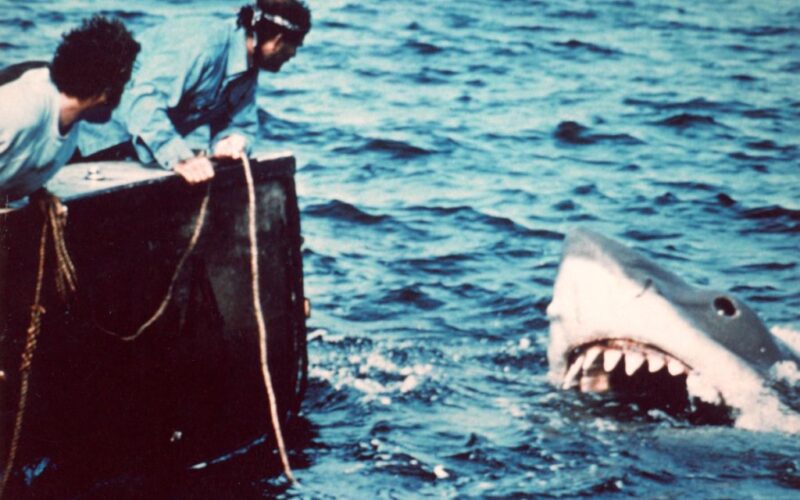I first saw “Jaws” during its theatrical debut in 1975 when I was 15. The previous year, family friends had loaned me Peter Benchley’s novel. The book and film terrified me. But I had been a shark-obsessed kid for years, so fascination outweighed fear.
Fifty years later, as a shark biologist, and with the summer’s annual Shark Week starting tomorrow, I think about how our views on sharks have changed over the last five decades. And how they haven’t.
Technological advances since the mid-1970s, including acoustic and satellite telemetry, inexpensive underwater cameras, and aerial and underwater drones, have given us insights into the biology, ecology, and behavior of sharks that were previously unobtainable. Those of us driven back into the ocean to become marine biologists after seeing “Jaws” have learned that this group of animals bears little resemblance to the antagonist of the book and film.
No sharks, including the infamous white shark, target people as food; most don’t even recognize anything our size as potential food. While all sharks are carnivores, their diets vary widely. Adult white sharks primarily target marine mammals such as seals, but juveniles eat fish. Whale sharks and basking sharks have hundreds of teeth but don’t bite anything; they strain tiny animals out of seawater using special structures on their gills. Dusky smooth-hound sharks (a.k.a. smooth dogfish) have blunt teeth capable only of eating soft-bodied animals.
Sharks’ role in the food web is to keep marine animal populations in balance. Sharks in public aquariums have demonstrated remarkable intelligence and willingness to work with their caretakers. They are a far cry from the mindless killing machine depicted in “Jaws.”
We cannot blame Peter Benchley or Steven Spielberg for demonizing sharks. A number of events during the last century contributed to our fears. Until the early 20th century, stories of shark attacks were considered mariners’ tall tales, lumped in with mermaid and sea serpent sightings. This changed after a series of shark attacks off the New Jersey coast in 1916.
It was big news that summer but quickly forgotten when the U.S. entered World War I. Millions of people died during that war, and millions more of swine flu soon after. During World War II, frightening stories of encounters between sharks and military personnel in the Indo-Pacific prompted the U.S. Navy to allocate funding for marine biologists to study sharks with intent to develop a shark repellent to keep service members safe at sea. A Navy doctor was tasked with running statistical analyses of all reported shark attacks. This was the dawn of modern shark research.
By 1974, no effective shark repellent had been developed. The Navy doctor’s analyses concluded that, except for unusual disasters at sea, the risk of shark attack to humans was statistically insignificant. His published report was read by the military and scientific community. Unfortunately, earlier that same year, the novel “Jaws” came out and was read by millions. The following year, the film became the world’s first summer blockbuster.
So the fear lingers. It doesn’t help that current mainstream and social media thrives on sensation. Scary shark stories remain wildly popular, but shark “attacks” remain incredibly rare, in keeping with the Navy’s findings 50 years ago. And most incidents labeled “attacks” — and all of those occurring in recent years in local New York waters — most likely result from one of us inadvertently getting caught in the crossfire between a feeding shark and its intended prey, typically small schooling baitfish.
The Atlantic menhaden (also called “bunker”) is one of the most common local baitfish. When a menhaden school comes close to shore, sharks sometimes follow them in. The school’s presence tends to be fairly easy to spot. Look for an unusual rippling disturbance on the water’s surface, sometimes accompanied by birds diving into the water to feed. It is best to stay on shore when you see this. The school will eventually move on, the shark will follow, and you may safely enter the water.
Please do not blame “Jaws” for our ongoing fear of sharks. “Jaws” was a fictionalized manifestation of those fears that had been brewing for decades based on how little humans knew about sharks. And it was never intended to be anything but a horror story, an adventure yarn, a buddy movie, an entertainment. Enjoy the novel. Enjoy the film. And enjoy your day at the beach. Just keep an eye out for signs of baitfish before you enter the water.
Walters is curator of animals at the Wildlife Conservation Society’s New York Aquarium and a field scientist with WCS’s New York Seascape Program.








